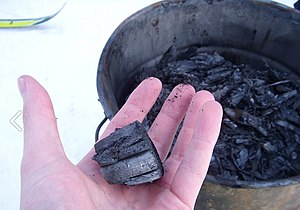生物炭
外觀

生物炭(英語:Biochar)有別於一般用於燃料之傳統木炭,是一種作為農業土壤改良劑的木炭[1]以及碳收集及儲存使用,農業上使用幫助植物生長,但對土壤團粒化沒有影響[2]。
跟木炭一樣,生物炭是用生物質能原料(例如木材、樹葉或枯死的植物),經熱裂解之後的產物。其主要的成份是碳分子,因為以無氧或極少氧方式經高溫加熱產生,在製造過程中,不會像平常燃燒有機物一般,釋放出大量的甲烷和二氧化碳。因為對亞馬遜黑土的研究,讓科學家開始對生物炭發生興趣。在日本,在農業上使用生物炭也有長久的歷史。
近年因為排放二氧化碳、一氧化二氮及甲烷等溫室氣體造成氣候變遷影響,讓科學家開始重視生物炭之運用,因為它有助於藉由生物炭封存的方式,捕捉與清除大氣中的溫室氣體,將它轉化成非常穩定的形式,並儲存在土壤中達數千年之久。[3][4][5]
此外,使用生物炭,可以增加20%的農業生產力、淨化水質,並有助於減少化學肥料的使用。[4][5]
註釋
[編輯]- ^ Read, Peter. This gift of nature is the best way to save us from climate catastrophe. Biochar schemes would remove carbon from the atmosphere and increase food supply, says Peter Read. Guardian (London). 27 March 2009 [2015-11-09]. (原始內容存檔於2012-03-26).
- ^ Sarker, T. C.; Incerti, G.; Spaccini, R.; R., Piccolo; Mazzoleni, S.; Bonanomi, G. Linking organic matter chemistry with soil aggregate stability: Insight from 13C NMR spectroscopy.. Soil Biology and Biochemistry. 2018, 117: 175–184 [2019-12-12]. (原始內容存檔於2019-12-12).
- ^ Lean, Geoffrey. Ancient skills 'could reverse global warming'. The Independent. 7 December 2008 [1 October 2011]. (原始內容存檔於2011年9月13日).
- ^ 4.0 4.1 Geoengineering the climate: science, governance and uncertainty. The Royal Society. 2009 [22 August 2010]. (原始內容存檔於2011-09-08).
- ^ 5.0 5.1 Dominic Woolf, James E. Amonette, F. Alayne Street-Perrott, Johannes Lehmann, Stephen Joseph; Amonette; Street-Perrott; Lehmann; Joseph. Sustainable biochar to mitigate global climate change. Nature Communications. August 2010, 1 (5): 1–9. Bibcode:2010NatCo...1E..56W. ISSN 2041-1723. doi:10.1038/ncomms1053.
參見
[編輯]外部連結
[編輯]- (英文)International Biochar Initiative (頁面存檔備份,存於網際網路檔案館)
- (英文)Biochar Fund(使用生物炭來解決糧食安全、森林破壞、地力衰竭、能源匱乏與氣候變遷之非營利組織)
- (英文)Biochar Research at Cornell University. [2011-04-17]. (原始內容存檔於2020-11-01).
- (英文)Biochar Carbon Sequestration - Home (頁面存檔備份,存於網際網路檔案館)


